Marketing Portfolio Analysis
VerifiedAdded on 2020/05/11
|11
|2866
|37
AI Summary
This assignment presents a comprehensive analysis of various key marketing concepts through the lens of different companies. It includes market research on Samsung, competitive analysis of P&G products, PESTLE analysis of Honda, SWOT analysis of Lakme, marketing strategy of Starbucks, and ethical issues faced by Volkswagen. The report aims to demonstrate the practical application of these marketing tools in real-world business scenarios.
Contribute Materials
Your contribution can guide someone’s learning journey. Share your
documents today.
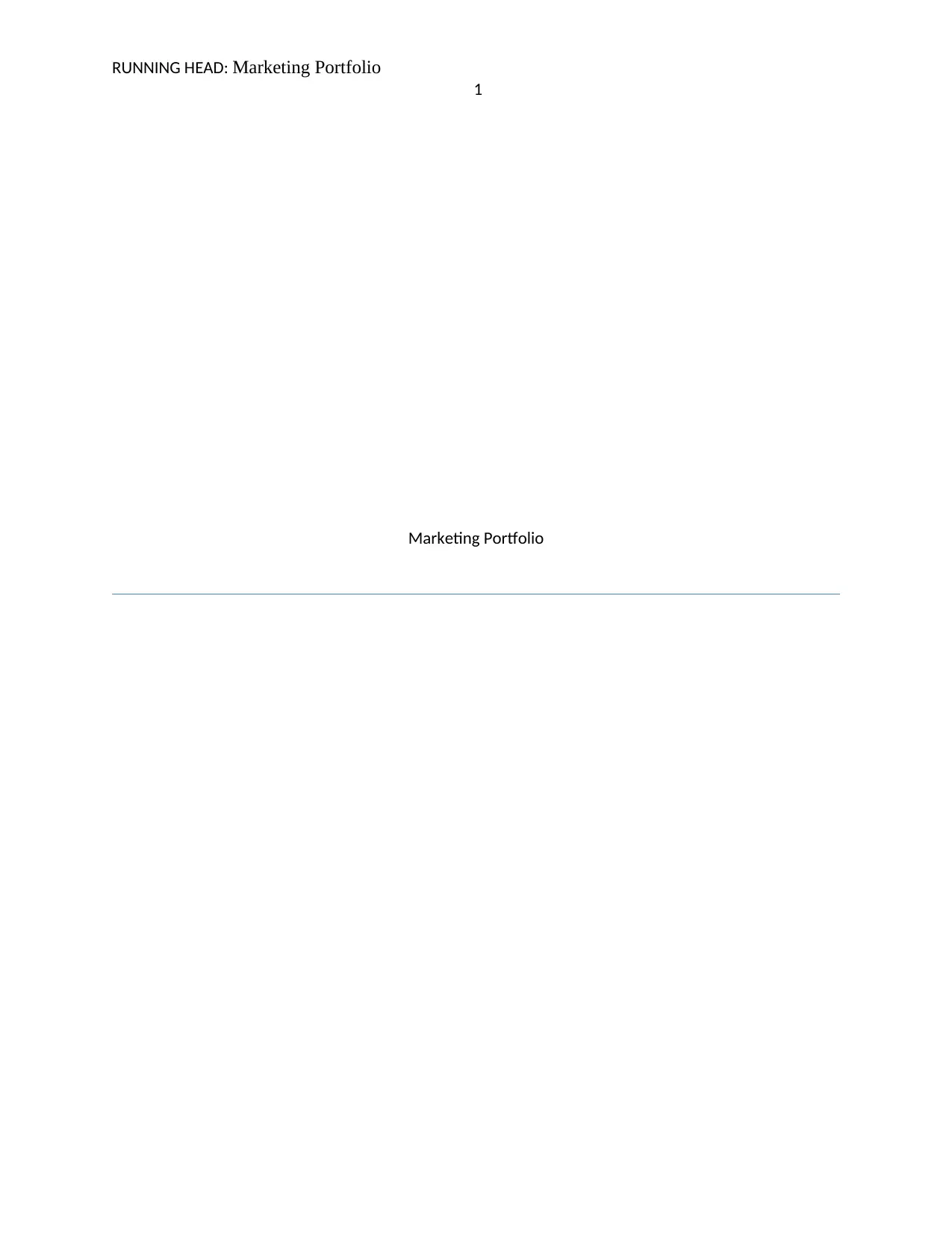
RUNNING HEAD: Marketing Portfolio
1
Marketing Portfolio
1
Marketing Portfolio
Secure Best Marks with AI Grader
Need help grading? Try our AI Grader for instant feedback on your assignments.
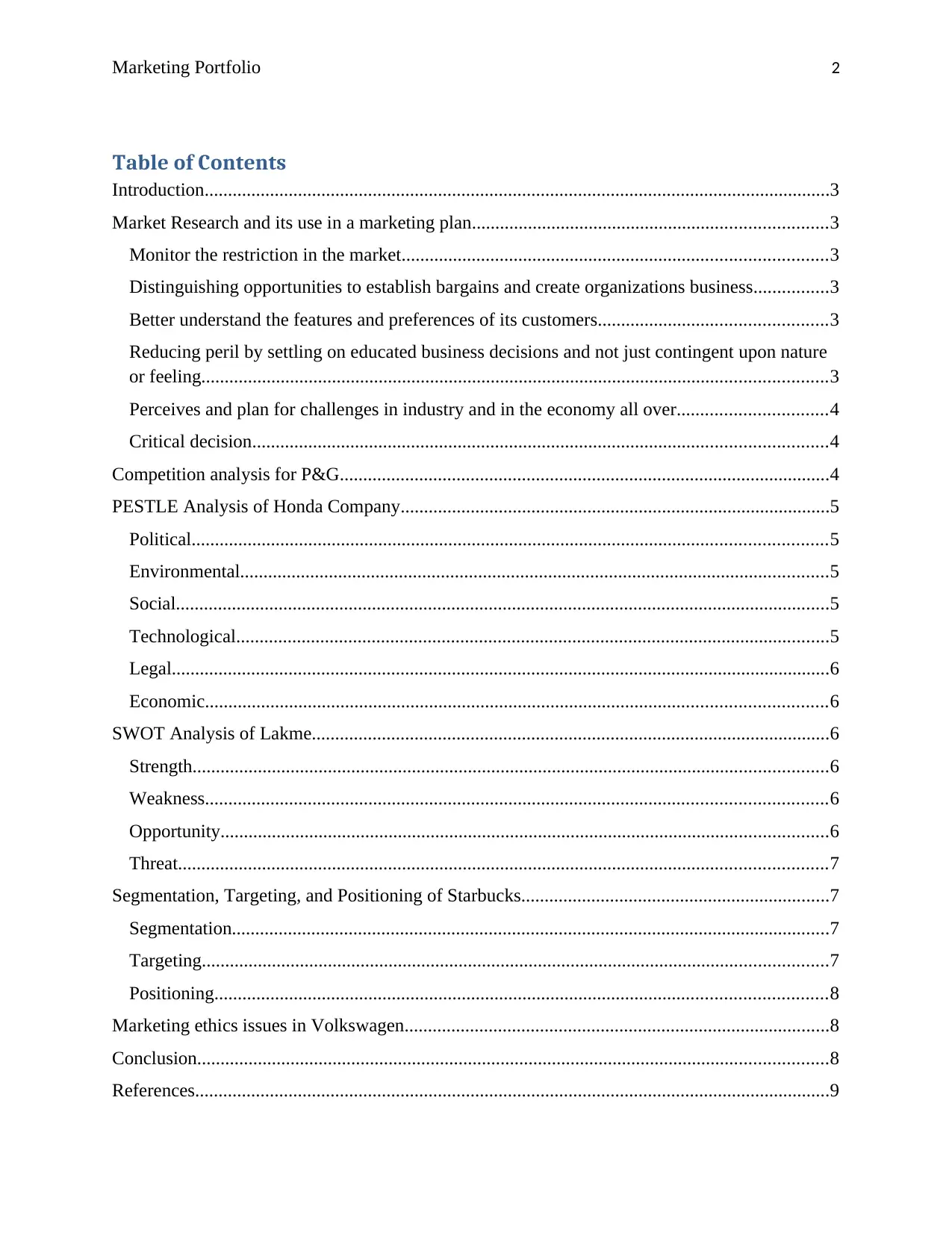
Marketing Portfolio 2
Table of Contents
Introduction......................................................................................................................................3
Market Research and its use in a marketing plan............................................................................3
Monitor the restriction in the market...........................................................................................3
Distinguishing opportunities to establish bargains and create organizations business................3
Better understand the features and preferences of its customers.................................................3
Reducing peril by settling on educated business decisions and not just contingent upon nature
or feeling......................................................................................................................................3
Perceives and plan for challenges in industry and in the economy all over................................4
Critical decision...........................................................................................................................4
Competition analysis for P&G.........................................................................................................4
PESTLE Analysis of Honda Company............................................................................................5
Political........................................................................................................................................5
Environmental..............................................................................................................................5
Social............................................................................................................................................5
Technological...............................................................................................................................5
Legal.............................................................................................................................................6
Economic.....................................................................................................................................6
SWOT Analysis of Lakme...............................................................................................................6
Strength........................................................................................................................................6
Weakness.....................................................................................................................................6
Opportunity..................................................................................................................................6
Threat...........................................................................................................................................7
Segmentation, Targeting, and Positioning of Starbucks..................................................................7
Segmentation................................................................................................................................7
Targeting......................................................................................................................................7
Positioning...................................................................................................................................8
Marketing ethics issues in Volkswagen...........................................................................................8
Conclusion.......................................................................................................................................8
References........................................................................................................................................9
Table of Contents
Introduction......................................................................................................................................3
Market Research and its use in a marketing plan............................................................................3
Monitor the restriction in the market...........................................................................................3
Distinguishing opportunities to establish bargains and create organizations business................3
Better understand the features and preferences of its customers.................................................3
Reducing peril by settling on educated business decisions and not just contingent upon nature
or feeling......................................................................................................................................3
Perceives and plan for challenges in industry and in the economy all over................................4
Critical decision...........................................................................................................................4
Competition analysis for P&G.........................................................................................................4
PESTLE Analysis of Honda Company............................................................................................5
Political........................................................................................................................................5
Environmental..............................................................................................................................5
Social............................................................................................................................................5
Technological...............................................................................................................................5
Legal.............................................................................................................................................6
Economic.....................................................................................................................................6
SWOT Analysis of Lakme...............................................................................................................6
Strength........................................................................................................................................6
Weakness.....................................................................................................................................6
Opportunity..................................................................................................................................6
Threat...........................................................................................................................................7
Segmentation, Targeting, and Positioning of Starbucks..................................................................7
Segmentation................................................................................................................................7
Targeting......................................................................................................................................7
Positioning...................................................................................................................................8
Marketing ethics issues in Volkswagen...........................................................................................8
Conclusion.......................................................................................................................................8
References........................................................................................................................................9
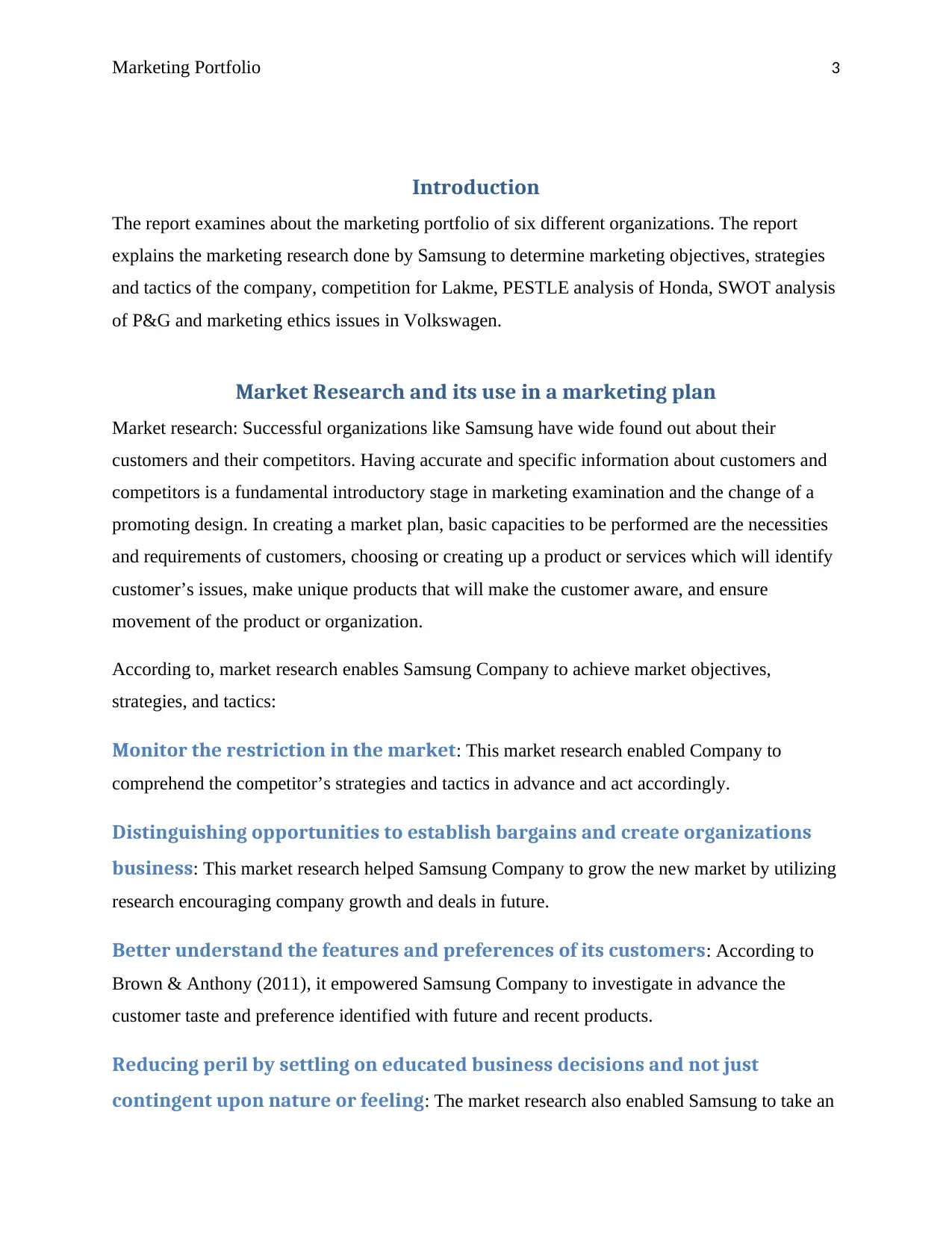
Marketing Portfolio 3
Introduction
The report examines about the marketing portfolio of six different organizations. The report
explains the marketing research done by Samsung to determine marketing objectives, strategies
and tactics of the company, competition for Lakme, PESTLE analysis of Honda, SWOT analysis
of P&G and marketing ethics issues in Volkswagen.
Market Research and its use in a marketing plan
Market research: Successful organizations like Samsung have wide found out about their
customers and their competitors. Having accurate and specific information about customers and
competitors is a fundamental introductory stage in marketing examination and the change of a
promoting design. In creating a market plan, basic capacities to be performed are the necessities
and requirements of customers, choosing or creating up a product or services which will identify
customer’s issues, make unique products that will make the customer aware, and ensure
movement of the product or organization.
According to, market research enables Samsung Company to achieve market objectives,
strategies, and tactics:
Monitor the restriction in the market: This market research enabled Company to
comprehend the competitor’s strategies and tactics in advance and act accordingly.
Distinguishing opportunities to establish bargains and create organizations
business: This market research helped Samsung Company to grow the new market by utilizing
research encouraging company growth and deals in future.
Better understand the features and preferences of its customers: According to
Brown & Anthony (2011), it empowered Samsung Company to investigate in advance the
customer taste and preference identified with future and recent products.
Reducing peril by settling on educated business decisions and not just
contingent upon nature or feeling: The market research also enabled Samsung to take an
Introduction
The report examines about the marketing portfolio of six different organizations. The report
explains the marketing research done by Samsung to determine marketing objectives, strategies
and tactics of the company, competition for Lakme, PESTLE analysis of Honda, SWOT analysis
of P&G and marketing ethics issues in Volkswagen.
Market Research and its use in a marketing plan
Market research: Successful organizations like Samsung have wide found out about their
customers and their competitors. Having accurate and specific information about customers and
competitors is a fundamental introductory stage in marketing examination and the change of a
promoting design. In creating a market plan, basic capacities to be performed are the necessities
and requirements of customers, choosing or creating up a product or services which will identify
customer’s issues, make unique products that will make the customer aware, and ensure
movement of the product or organization.
According to, market research enables Samsung Company to achieve market objectives,
strategies, and tactics:
Monitor the restriction in the market: This market research enabled Company to
comprehend the competitor’s strategies and tactics in advance and act accordingly.
Distinguishing opportunities to establish bargains and create organizations
business: This market research helped Samsung Company to grow the new market by utilizing
research encouraging company growth and deals in future.
Better understand the features and preferences of its customers: According to
Brown & Anthony (2011), it empowered Samsung Company to investigate in advance the
customer taste and preference identified with future and recent products.
Reducing peril by settling on educated business decisions and not just
contingent upon nature or feeling: The market research also enabled Samsung to take an
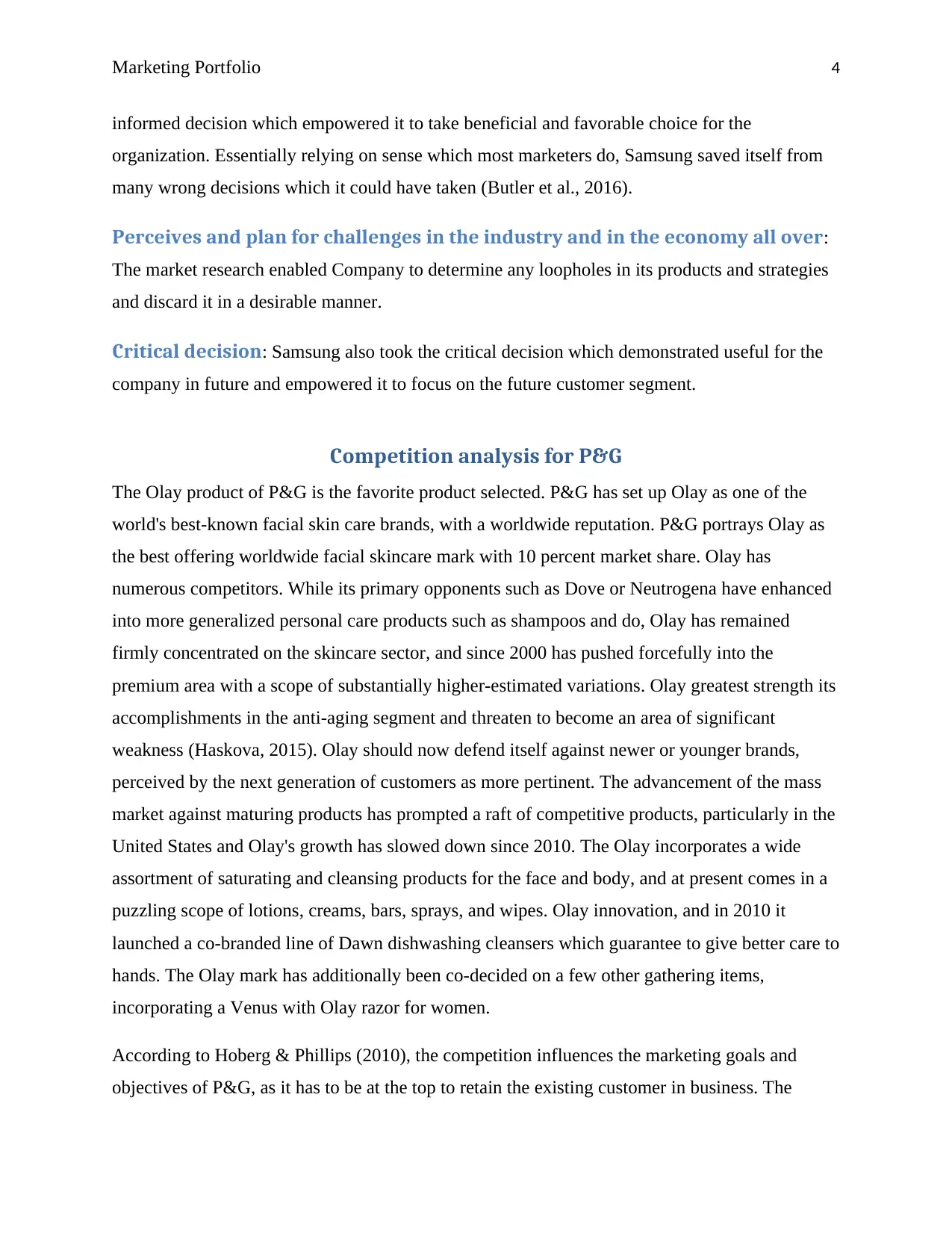
Marketing Portfolio 4
informed decision which empowered it to take beneficial and favorable choice for the
organization. Essentially relying on sense which most marketers do, Samsung saved itself from
many wrong decisions which it could have taken (Butler et al., 2016).
Perceives and plan for challenges in the industry and in the economy all over:
The market research enabled Company to determine any loopholes in its products and strategies
and discard it in a desirable manner.
Critical decision: Samsung also took the critical decision which demonstrated useful for the
company in future and empowered it to focus on the future customer segment.
Competition analysis for P&G
The Olay product of P&G is the favorite product selected. P&G has set up Olay as one of the
world's best-known facial skin care brands, with a worldwide reputation. P&G portrays Olay as
the best offering worldwide facial skincare mark with 10 percent market share. Olay has
numerous competitors. While its primary opponents such as Dove or Neutrogena have enhanced
into more generalized personal care products such as shampoos and do, Olay has remained
firmly concentrated on the skincare sector, and since 2000 has pushed forcefully into the
premium area with a scope of substantially higher-estimated variations. Olay greatest strength its
accomplishments in the anti-aging segment and threaten to become an area of significant
weakness (Haskova, 2015). Olay should now defend itself against newer or younger brands,
perceived by the next generation of customers as more pertinent. The advancement of the mass
market against maturing products has prompted a raft of competitive products, particularly in the
United States and Olay's growth has slowed down since 2010. The Olay incorporates a wide
assortment of saturating and cleansing products for the face and body, and at present comes in a
puzzling scope of lotions, creams, bars, sprays, and wipes. Olay innovation, and in 2010 it
launched a co-branded line of Dawn dishwashing cleansers which guarantee to give better care to
hands. The Olay mark has additionally been co-decided on a few other gathering items,
incorporating a Venus with Olay razor for women.
According to Hoberg & Phillips (2010), the competition influences the marketing goals and
objectives of P&G, as it has to be at the top to retain the existing customer in business. The
informed decision which empowered it to take beneficial and favorable choice for the
organization. Essentially relying on sense which most marketers do, Samsung saved itself from
many wrong decisions which it could have taken (Butler et al., 2016).
Perceives and plan for challenges in the industry and in the economy all over:
The market research enabled Company to determine any loopholes in its products and strategies
and discard it in a desirable manner.
Critical decision: Samsung also took the critical decision which demonstrated useful for the
company in future and empowered it to focus on the future customer segment.
Competition analysis for P&G
The Olay product of P&G is the favorite product selected. P&G has set up Olay as one of the
world's best-known facial skin care brands, with a worldwide reputation. P&G portrays Olay as
the best offering worldwide facial skincare mark with 10 percent market share. Olay has
numerous competitors. While its primary opponents such as Dove or Neutrogena have enhanced
into more generalized personal care products such as shampoos and do, Olay has remained
firmly concentrated on the skincare sector, and since 2000 has pushed forcefully into the
premium area with a scope of substantially higher-estimated variations. Olay greatest strength its
accomplishments in the anti-aging segment and threaten to become an area of significant
weakness (Haskova, 2015). Olay should now defend itself against newer or younger brands,
perceived by the next generation of customers as more pertinent. The advancement of the mass
market against maturing products has prompted a raft of competitive products, particularly in the
United States and Olay's growth has slowed down since 2010. The Olay incorporates a wide
assortment of saturating and cleansing products for the face and body, and at present comes in a
puzzling scope of lotions, creams, bars, sprays, and wipes. Olay innovation, and in 2010 it
launched a co-branded line of Dawn dishwashing cleansers which guarantee to give better care to
hands. The Olay mark has additionally been co-decided on a few other gathering items,
incorporating a Venus with Olay razor for women.
According to Hoberg & Phillips (2010), the competition influences the marketing goals and
objectives of P&G, as it has to be at the top to retain the existing customer in business. The
Secure Best Marks with AI Grader
Need help grading? Try our AI Grader for instant feedback on your assignments.
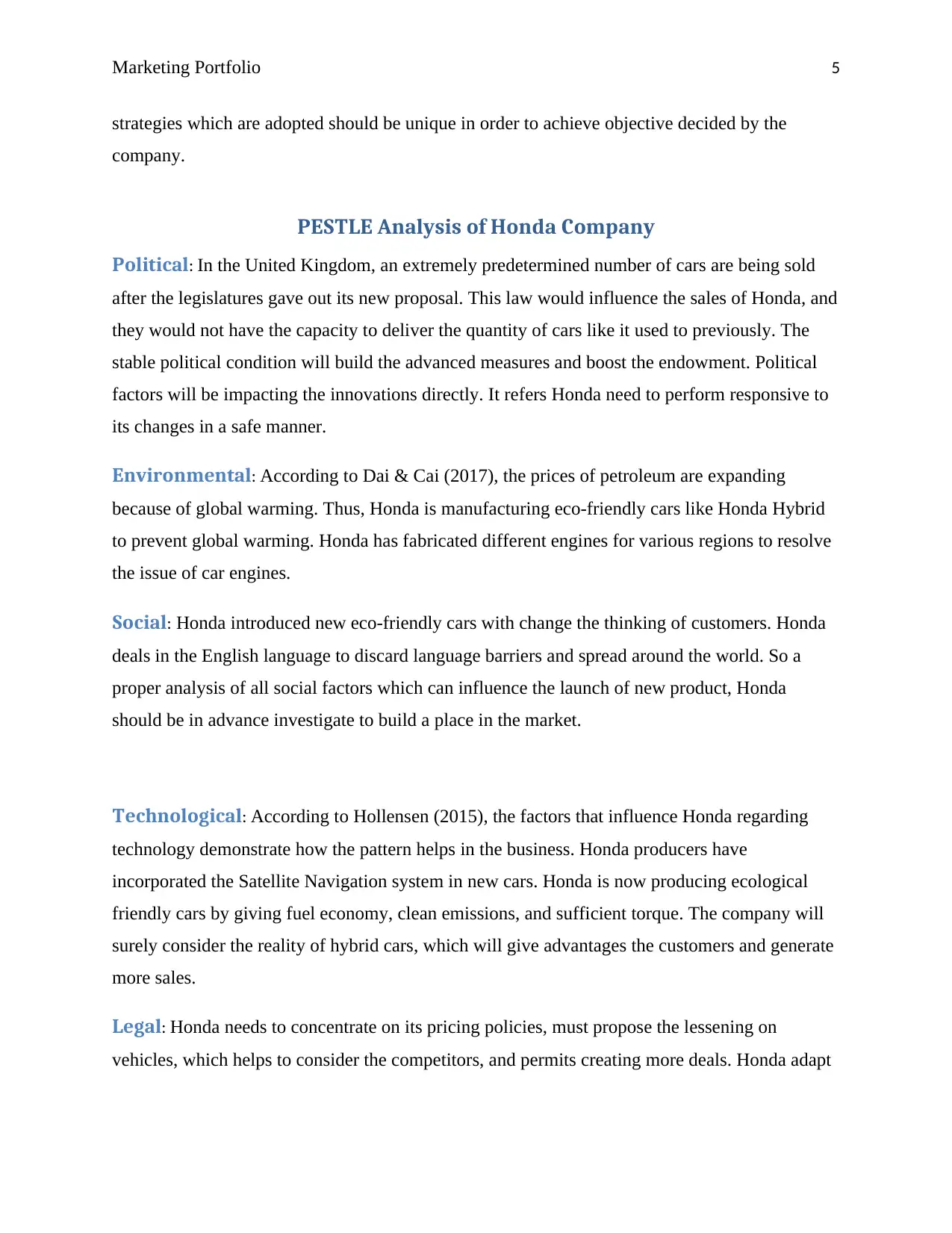
Marketing Portfolio 5
strategies which are adopted should be unique in order to achieve objective decided by the
company.
PESTLE Analysis of Honda Company
Political: In the United Kingdom, an extremely predetermined number of cars are being sold
after the legislatures gave out its new proposal. This law would influence the sales of Honda, and
they would not have the capacity to deliver the quantity of cars like it used to previously. The
stable political condition will build the advanced measures and boost the endowment. Political
factors will be impacting the innovations directly. It refers Honda need to perform responsive to
its changes in a safe manner.
Environmental: According to Dai & Cai (2017), the prices of petroleum are expanding
because of global warming. Thus, Honda is manufacturing eco-friendly cars like Honda Hybrid
to prevent global warming. Honda has fabricated different engines for various regions to resolve
the issue of car engines.
Social: Honda introduced new eco-friendly cars with change the thinking of customers. Honda
deals in the English language to discard language barriers and spread around the world. So a
proper analysis of all social factors which can influence the launch of new product, Honda
should be in advance investigate to build a place in the market.
Technological: According to Hollensen (2015), the factors that influence Honda regarding
technology demonstrate how the pattern helps in the business. Honda producers have
incorporated the Satellite Navigation system in new cars. Honda is now producing ecological
friendly cars by giving fuel economy, clean emissions, and sufficient torque. The company will
surely consider the reality of hybrid cars, which will give advantages the customers and generate
more sales.
Legal: Honda needs to concentrate on its pricing policies, must propose the lessening on
vehicles, which helps to consider the competitors, and permits creating more deals. Honda adapt
strategies which are adopted should be unique in order to achieve objective decided by the
company.
PESTLE Analysis of Honda Company
Political: In the United Kingdom, an extremely predetermined number of cars are being sold
after the legislatures gave out its new proposal. This law would influence the sales of Honda, and
they would not have the capacity to deliver the quantity of cars like it used to previously. The
stable political condition will build the advanced measures and boost the endowment. Political
factors will be impacting the innovations directly. It refers Honda need to perform responsive to
its changes in a safe manner.
Environmental: According to Dai & Cai (2017), the prices of petroleum are expanding
because of global warming. Thus, Honda is manufacturing eco-friendly cars like Honda Hybrid
to prevent global warming. Honda has fabricated different engines for various regions to resolve
the issue of car engines.
Social: Honda introduced new eco-friendly cars with change the thinking of customers. Honda
deals in the English language to discard language barriers and spread around the world. So a
proper analysis of all social factors which can influence the launch of new product, Honda
should be in advance investigate to build a place in the market.
Technological: According to Hollensen (2015), the factors that influence Honda regarding
technology demonstrate how the pattern helps in the business. Honda producers have
incorporated the Satellite Navigation system in new cars. Honda is now producing ecological
friendly cars by giving fuel economy, clean emissions, and sufficient torque. The company will
surely consider the reality of hybrid cars, which will give advantages the customers and generate
more sales.
Legal: Honda needs to concentrate on its pricing policies, must propose the lessening on
vehicles, which helps to consider the competitors, and permits creating more deals. Honda adapt
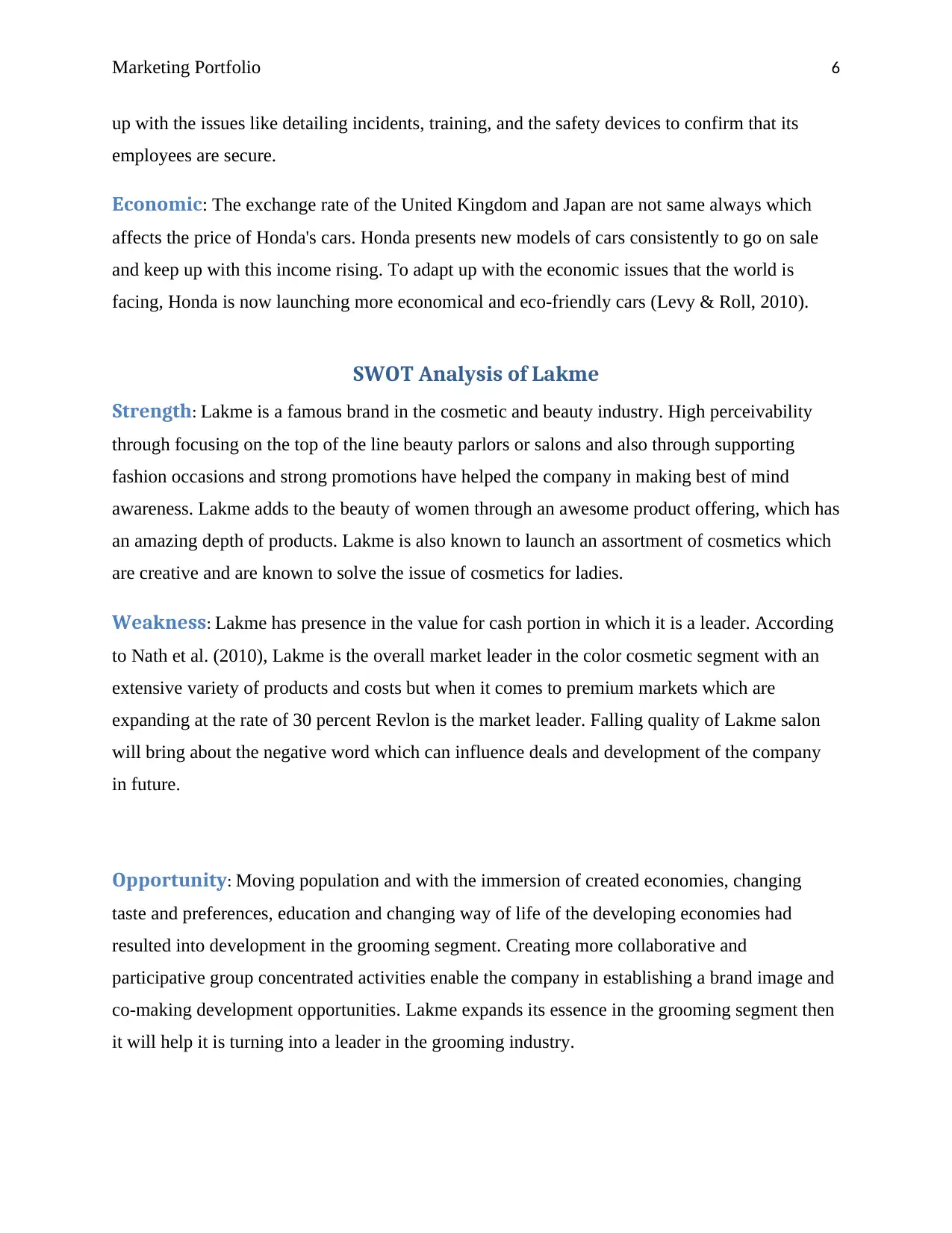
Marketing Portfolio 6
up with the issues like detailing incidents, training, and the safety devices to confirm that its
employees are secure.
Economic: The exchange rate of the United Kingdom and Japan are not same always which
affects the price of Honda's cars. Honda presents new models of cars consistently to go on sale
and keep up with this income rising. To adapt up with the economic issues that the world is
facing, Honda is now launching more economical and eco-friendly cars (Levy & Roll, 2010).
SWOT Analysis of Lakme
Strength: Lakme is a famous brand in the cosmetic and beauty industry. High perceivability
through focusing on the top of the line beauty parlors or salons and also through supporting
fashion occasions and strong promotions have helped the company in making best of mind
awareness. Lakme adds to the beauty of women through an awesome product offering, which has
an amazing depth of products. Lakme is also known to launch an assortment of cosmetics which
are creative and are known to solve the issue of cosmetics for ladies.
Weakness: Lakme has presence in the value for cash portion in which it is a leader. According
to Nath et al. (2010), Lakme is the overall market leader in the color cosmetic segment with an
extensive variety of products and costs but when it comes to premium markets which are
expanding at the rate of 30 percent Revlon is the market leader. Falling quality of Lakme salon
will bring about the negative word which can influence deals and development of the company
in future.
Opportunity: Moving population and with the immersion of created economies, changing
taste and preferences, education and changing way of life of the developing economies had
resulted into development in the grooming segment. Creating more collaborative and
participative group concentrated activities enable the company in establishing a brand image and
co-making development opportunities. Lakme expands its essence in the grooming segment then
it will help it is turning into a leader in the grooming industry.
up with the issues like detailing incidents, training, and the safety devices to confirm that its
employees are secure.
Economic: The exchange rate of the United Kingdom and Japan are not same always which
affects the price of Honda's cars. Honda presents new models of cars consistently to go on sale
and keep up with this income rising. To adapt up with the economic issues that the world is
facing, Honda is now launching more economical and eco-friendly cars (Levy & Roll, 2010).
SWOT Analysis of Lakme
Strength: Lakme is a famous brand in the cosmetic and beauty industry. High perceivability
through focusing on the top of the line beauty parlors or salons and also through supporting
fashion occasions and strong promotions have helped the company in making best of mind
awareness. Lakme adds to the beauty of women through an awesome product offering, which has
an amazing depth of products. Lakme is also known to launch an assortment of cosmetics which
are creative and are known to solve the issue of cosmetics for ladies.
Weakness: Lakme has presence in the value for cash portion in which it is a leader. According
to Nath et al. (2010), Lakme is the overall market leader in the color cosmetic segment with an
extensive variety of products and costs but when it comes to premium markets which are
expanding at the rate of 30 percent Revlon is the market leader. Falling quality of Lakme salon
will bring about the negative word which can influence deals and development of the company
in future.
Opportunity: Moving population and with the immersion of created economies, changing
taste and preferences, education and changing way of life of the developing economies had
resulted into development in the grooming segment. Creating more collaborative and
participative group concentrated activities enable the company in establishing a brand image and
co-making development opportunities. Lakme expands its essence in the grooming segment then
it will help it is turning into a leader in the grooming industry.
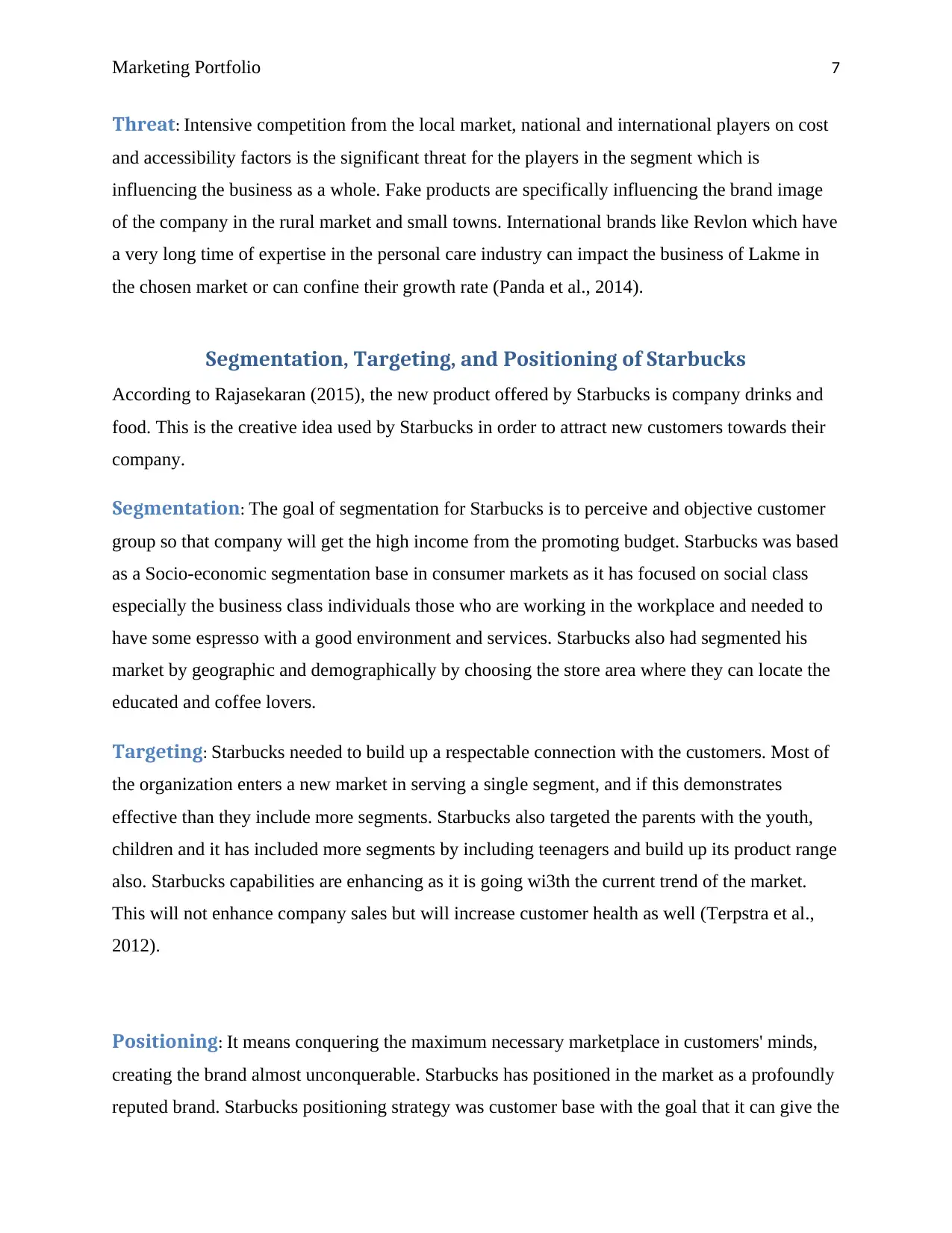
Marketing Portfolio 7
Threat: Intensive competition from the local market, national and international players on cost
and accessibility factors is the significant threat for the players in the segment which is
influencing the business as a whole. Fake products are specifically influencing the brand image
of the company in the rural market and small towns. International brands like Revlon which have
a very long time of expertise in the personal care industry can impact the business of Lakme in
the chosen market or can confine their growth rate (Panda et al., 2014).
Segmentation, Targeting, and Positioning of Starbucks
According to Rajasekaran (2015), the new product offered by Starbucks is company drinks and
food. This is the creative idea used by Starbucks in order to attract new customers towards their
company.
Segmentation: The goal of segmentation for Starbucks is to perceive and objective customer
group so that company will get the high income from the promoting budget. Starbucks was based
as a Socio-economic segmentation base in consumer markets as it has focused on social class
especially the business class individuals those who are working in the workplace and needed to
have some espresso with a good environment and services. Starbucks also had segmented his
market by geographic and demographically by choosing the store area where they can locate the
educated and coffee lovers.
Targeting: Starbucks needed to build up a respectable connection with the customers. Most of
the organization enters a new market in serving a single segment, and if this demonstrates
effective than they include more segments. Starbucks also targeted the parents with the youth,
children and it has included more segments by including teenagers and build up its product range
also. Starbucks capabilities are enhancing as it is going wi3th the current trend of the market.
This will not enhance company sales but will increase customer health as well (Terpstra et al.,
2012).
Positioning: It means conquering the maximum necessary marketplace in customers' minds,
creating the brand almost unconquerable. Starbucks has positioned in the market as a profoundly
reputed brand. Starbucks positioning strategy was customer base with the goal that it can give the
Threat: Intensive competition from the local market, national and international players on cost
and accessibility factors is the significant threat for the players in the segment which is
influencing the business as a whole. Fake products are specifically influencing the brand image
of the company in the rural market and small towns. International brands like Revlon which have
a very long time of expertise in the personal care industry can impact the business of Lakme in
the chosen market or can confine their growth rate (Panda et al., 2014).
Segmentation, Targeting, and Positioning of Starbucks
According to Rajasekaran (2015), the new product offered by Starbucks is company drinks and
food. This is the creative idea used by Starbucks in order to attract new customers towards their
company.
Segmentation: The goal of segmentation for Starbucks is to perceive and objective customer
group so that company will get the high income from the promoting budget. Starbucks was based
as a Socio-economic segmentation base in consumer markets as it has focused on social class
especially the business class individuals those who are working in the workplace and needed to
have some espresso with a good environment and services. Starbucks also had segmented his
market by geographic and demographically by choosing the store area where they can locate the
educated and coffee lovers.
Targeting: Starbucks needed to build up a respectable connection with the customers. Most of
the organization enters a new market in serving a single segment, and if this demonstrates
effective than they include more segments. Starbucks also targeted the parents with the youth,
children and it has included more segments by including teenagers and build up its product range
also. Starbucks capabilities are enhancing as it is going wi3th the current trend of the market.
This will not enhance company sales but will increase customer health as well (Terpstra et al.,
2012).
Positioning: It means conquering the maximum necessary marketplace in customers' minds,
creating the brand almost unconquerable. Starbucks has positioned in the market as a profoundly
reputed brand. Starbucks positioning strategy was customer base with the goal that it can give the
Paraphrase This Document
Need a fresh take? Get an instant paraphrase of this document with our AI Paraphraser
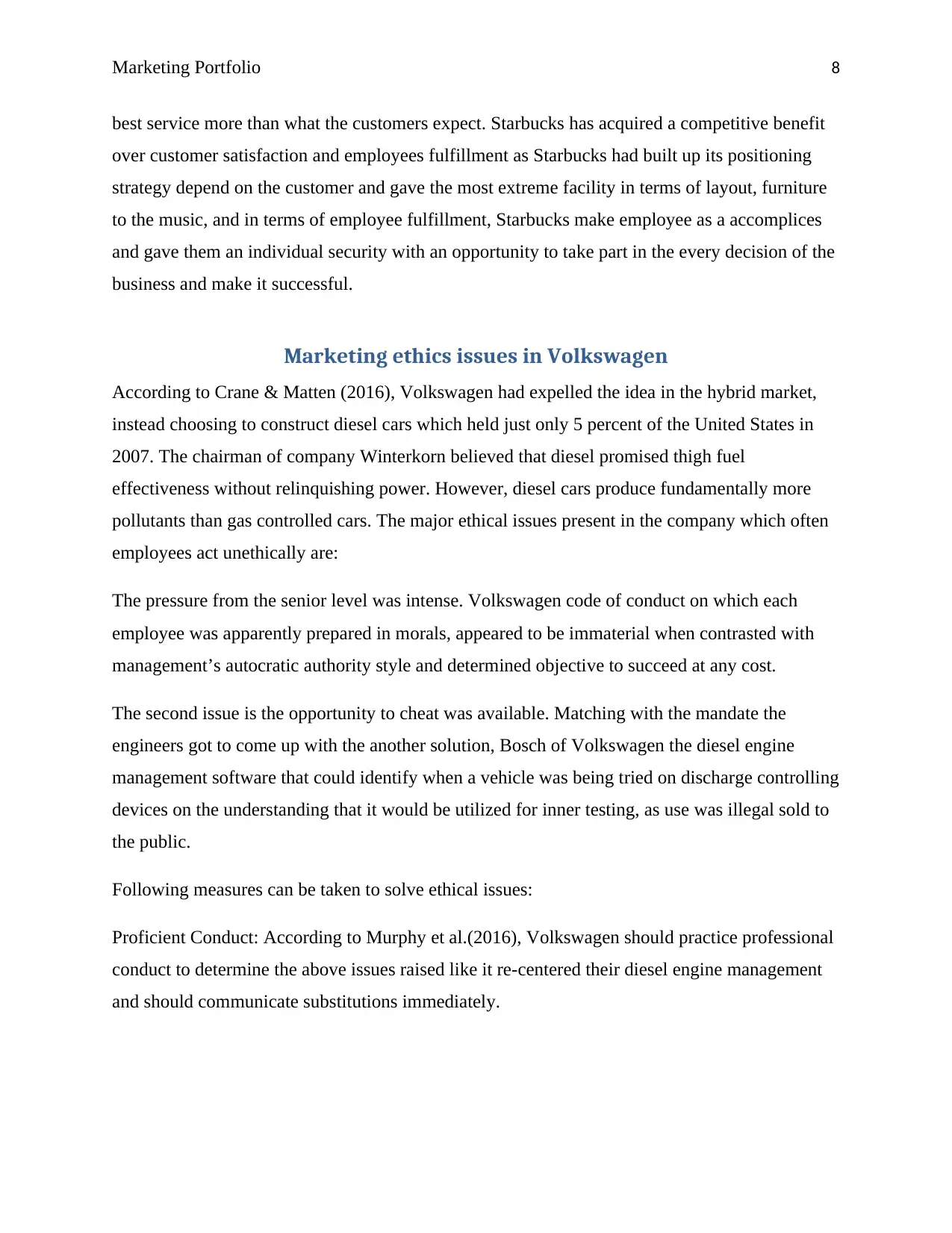
Marketing Portfolio 8
best service more than what the customers expect. Starbucks has acquired a competitive benefit
over customer satisfaction and employees fulfillment as Starbucks had built up its positioning
strategy depend on the customer and gave the most extreme facility in terms of layout, furniture
to the music, and in terms of employee fulfillment, Starbucks make employee as a accomplices
and gave them an individual security with an opportunity to take part in the every decision of the
business and make it successful.
Marketing ethics issues in Volkswagen
According to Crane & Matten (2016), Volkswagen had expelled the idea in the hybrid market,
instead choosing to construct diesel cars which held just only 5 percent of the United States in
2007. The chairman of company Winterkorn believed that diesel promised thigh fuel
effectiveness without relinquishing power. However, diesel cars produce fundamentally more
pollutants than gas controlled cars. The major ethical issues present in the company which often
employees act unethically are:
The pressure from the senior level was intense. Volkswagen code of conduct on which each
employee was apparently prepared in morals, appeared to be immaterial when contrasted with
management’s autocratic authority style and determined objective to succeed at any cost.
The second issue is the opportunity to cheat was available. Matching with the mandate the
engineers got to come up with the another solution, Bosch of Volkswagen the diesel engine
management software that could identify when a vehicle was being tried on discharge controlling
devices on the understanding that it would be utilized for inner testing, as use was illegal sold to
the public.
Following measures can be taken to solve ethical issues:
Proficient Conduct: According to Murphy et al.(2016), Volkswagen should practice professional
conduct to determine the above issues raised like it re-centered their diesel engine management
and should communicate substitutions immediately.
best service more than what the customers expect. Starbucks has acquired a competitive benefit
over customer satisfaction and employees fulfillment as Starbucks had built up its positioning
strategy depend on the customer and gave the most extreme facility in terms of layout, furniture
to the music, and in terms of employee fulfillment, Starbucks make employee as a accomplices
and gave them an individual security with an opportunity to take part in the every decision of the
business and make it successful.
Marketing ethics issues in Volkswagen
According to Crane & Matten (2016), Volkswagen had expelled the idea in the hybrid market,
instead choosing to construct diesel cars which held just only 5 percent of the United States in
2007. The chairman of company Winterkorn believed that diesel promised thigh fuel
effectiveness without relinquishing power. However, diesel cars produce fundamentally more
pollutants than gas controlled cars. The major ethical issues present in the company which often
employees act unethically are:
The pressure from the senior level was intense. Volkswagen code of conduct on which each
employee was apparently prepared in morals, appeared to be immaterial when contrasted with
management’s autocratic authority style and determined objective to succeed at any cost.
The second issue is the opportunity to cheat was available. Matching with the mandate the
engineers got to come up with the another solution, Bosch of Volkswagen the diesel engine
management software that could identify when a vehicle was being tried on discharge controlling
devices on the understanding that it would be utilized for inner testing, as use was illegal sold to
the public.
Following measures can be taken to solve ethical issues:
Proficient Conduct: According to Murphy et al.(2016), Volkswagen should practice professional
conduct to determine the above issues raised like it re-centered their diesel engine management
and should communicate substitutions immediately.
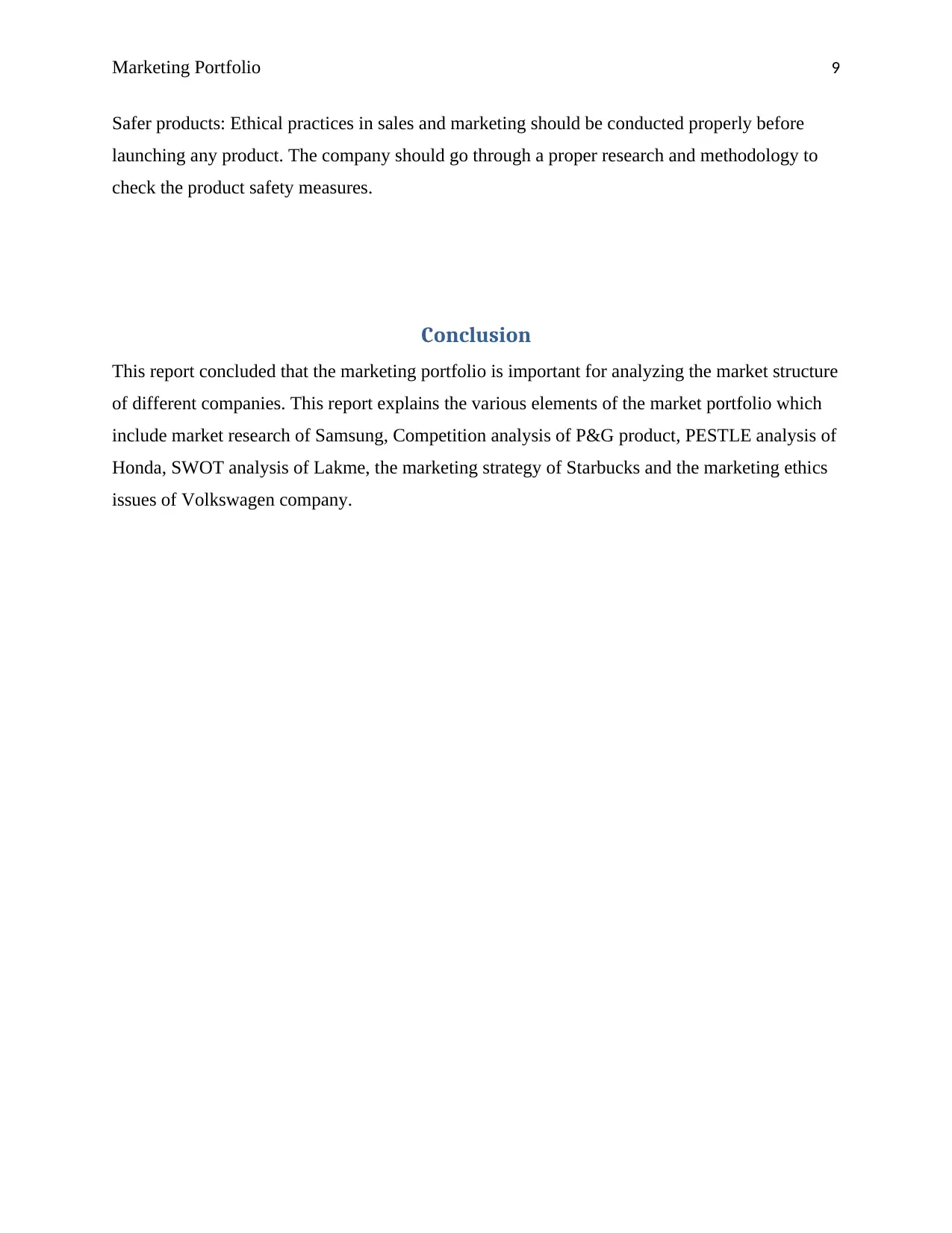
Marketing Portfolio 9
Safer products: Ethical practices in sales and marketing should be conducted properly before
launching any product. The company should go through a proper research and methodology to
check the product safety measures.
Conclusion
This report concluded that the marketing portfolio is important for analyzing the market structure
of different companies. This report explains the various elements of the market portfolio which
include market research of Samsung, Competition analysis of P&G product, PESTLE analysis of
Honda, SWOT analysis of Lakme, the marketing strategy of Starbucks and the marketing ethics
issues of Volkswagen company.
Safer products: Ethical practices in sales and marketing should be conducted properly before
launching any product. The company should go through a proper research and methodology to
check the product safety measures.
Conclusion
This report concluded that the marketing portfolio is important for analyzing the market structure
of different companies. This report explains the various elements of the market portfolio which
include market research of Samsung, Competition analysis of P&G product, PESTLE analysis of
Honda, SWOT analysis of Lakme, the marketing strategy of Starbucks and the marketing ethics
issues of Volkswagen company.
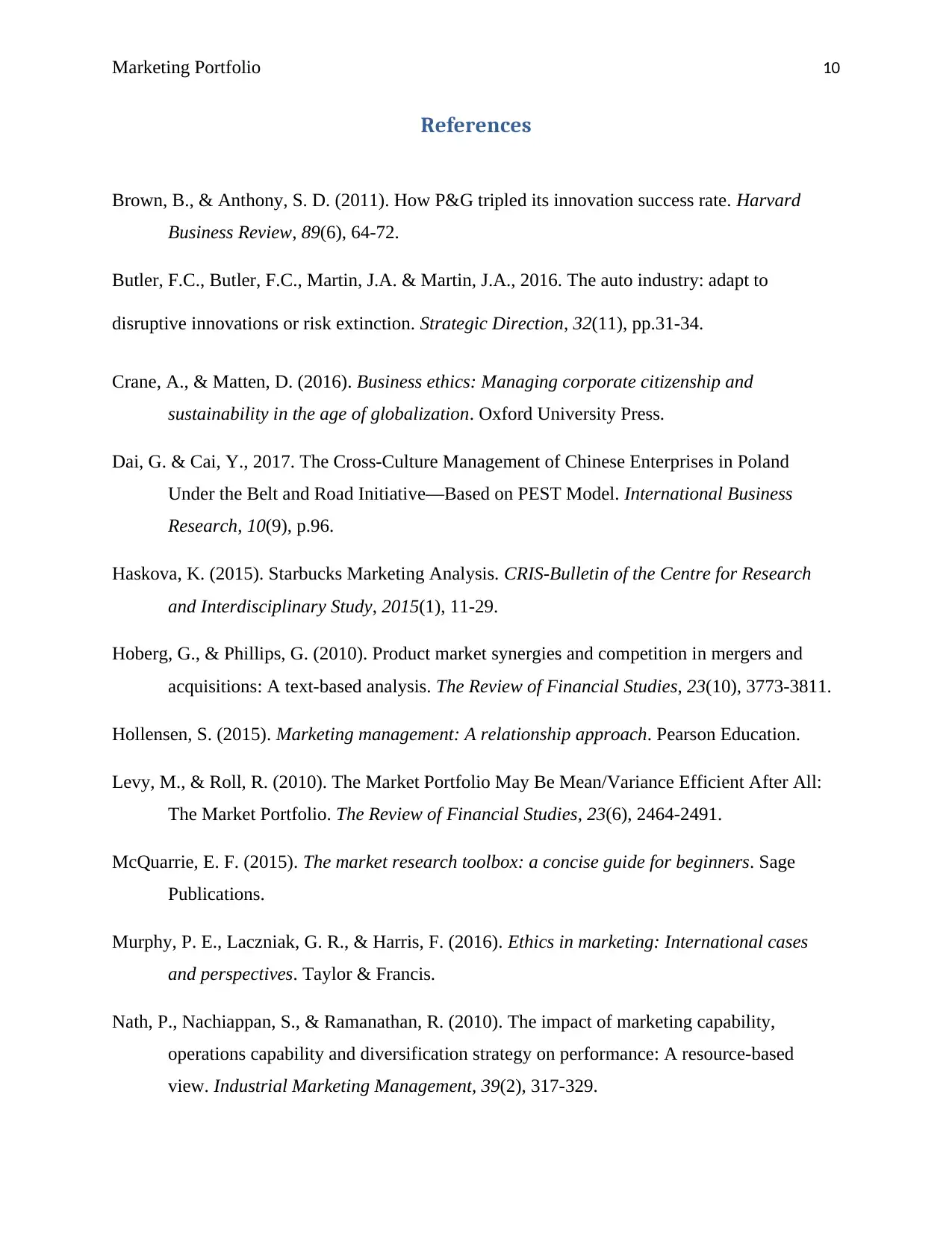
Marketing Portfolio 10
References
Brown, B., & Anthony, S. D. (2011). How P&G tripled its innovation success rate. Harvard
Business Review, 89(6), 64-72.
Butler, F.C., Butler, F.C., Martin, J.A. & Martin, J.A., 2016. The auto industry: adapt to
disruptive innovations or risk extinction. Strategic Direction, 32(11), pp.31-34.
Crane, A., & Matten, D. (2016). Business ethics: Managing corporate citizenship and
sustainability in the age of globalization. Oxford University Press.
Dai, G. & Cai, Y., 2017. The Cross-Culture Management of Chinese Enterprises in Poland
Under the Belt and Road Initiative—Based on PEST Model. International Business
Research, 10(9), p.96.
Haskova, K. (2015). Starbucks Marketing Analysis. CRIS-Bulletin of the Centre for Research
and Interdisciplinary Study, 2015(1), 11-29.
Hoberg, G., & Phillips, G. (2010). Product market synergies and competition in mergers and
acquisitions: A text-based analysis. The Review of Financial Studies, 23(10), 3773-3811.
Hollensen, S. (2015). Marketing management: A relationship approach. Pearson Education.
Levy, M., & Roll, R. (2010). The Market Portfolio May Be Mean/Variance Efficient After All:
The Market Portfolio. The Review of Financial Studies, 23(6), 2464-2491.
McQuarrie, E. F. (2015). The market research toolbox: a concise guide for beginners. Sage
Publications.
Murphy, P. E., Laczniak, G. R., & Harris, F. (2016). Ethics in marketing: International cases
and perspectives. Taylor & Francis.
Nath, P., Nachiappan, S., & Ramanathan, R. (2010). The impact of marketing capability,
operations capability and diversification strategy on performance: A resource-based
view. Industrial Marketing Management, 39(2), 317-329.
References
Brown, B., & Anthony, S. D. (2011). How P&G tripled its innovation success rate. Harvard
Business Review, 89(6), 64-72.
Butler, F.C., Butler, F.C., Martin, J.A. & Martin, J.A., 2016. The auto industry: adapt to
disruptive innovations or risk extinction. Strategic Direction, 32(11), pp.31-34.
Crane, A., & Matten, D. (2016). Business ethics: Managing corporate citizenship and
sustainability in the age of globalization. Oxford University Press.
Dai, G. & Cai, Y., 2017. The Cross-Culture Management of Chinese Enterprises in Poland
Under the Belt and Road Initiative—Based on PEST Model. International Business
Research, 10(9), p.96.
Haskova, K. (2015). Starbucks Marketing Analysis. CRIS-Bulletin of the Centre for Research
and Interdisciplinary Study, 2015(1), 11-29.
Hoberg, G., & Phillips, G. (2010). Product market synergies and competition in mergers and
acquisitions: A text-based analysis. The Review of Financial Studies, 23(10), 3773-3811.
Hollensen, S. (2015). Marketing management: A relationship approach. Pearson Education.
Levy, M., & Roll, R. (2010). The Market Portfolio May Be Mean/Variance Efficient After All:
The Market Portfolio. The Review of Financial Studies, 23(6), 2464-2491.
McQuarrie, E. F. (2015). The market research toolbox: a concise guide for beginners. Sage
Publications.
Murphy, P. E., Laczniak, G. R., & Harris, F. (2016). Ethics in marketing: International cases
and perspectives. Taylor & Francis.
Nath, P., Nachiappan, S., & Ramanathan, R. (2010). The impact of marketing capability,
operations capability and diversification strategy on performance: A resource-based
view. Industrial Marketing Management, 39(2), 317-329.
Secure Best Marks with AI Grader
Need help grading? Try our AI Grader for instant feedback on your assignments.
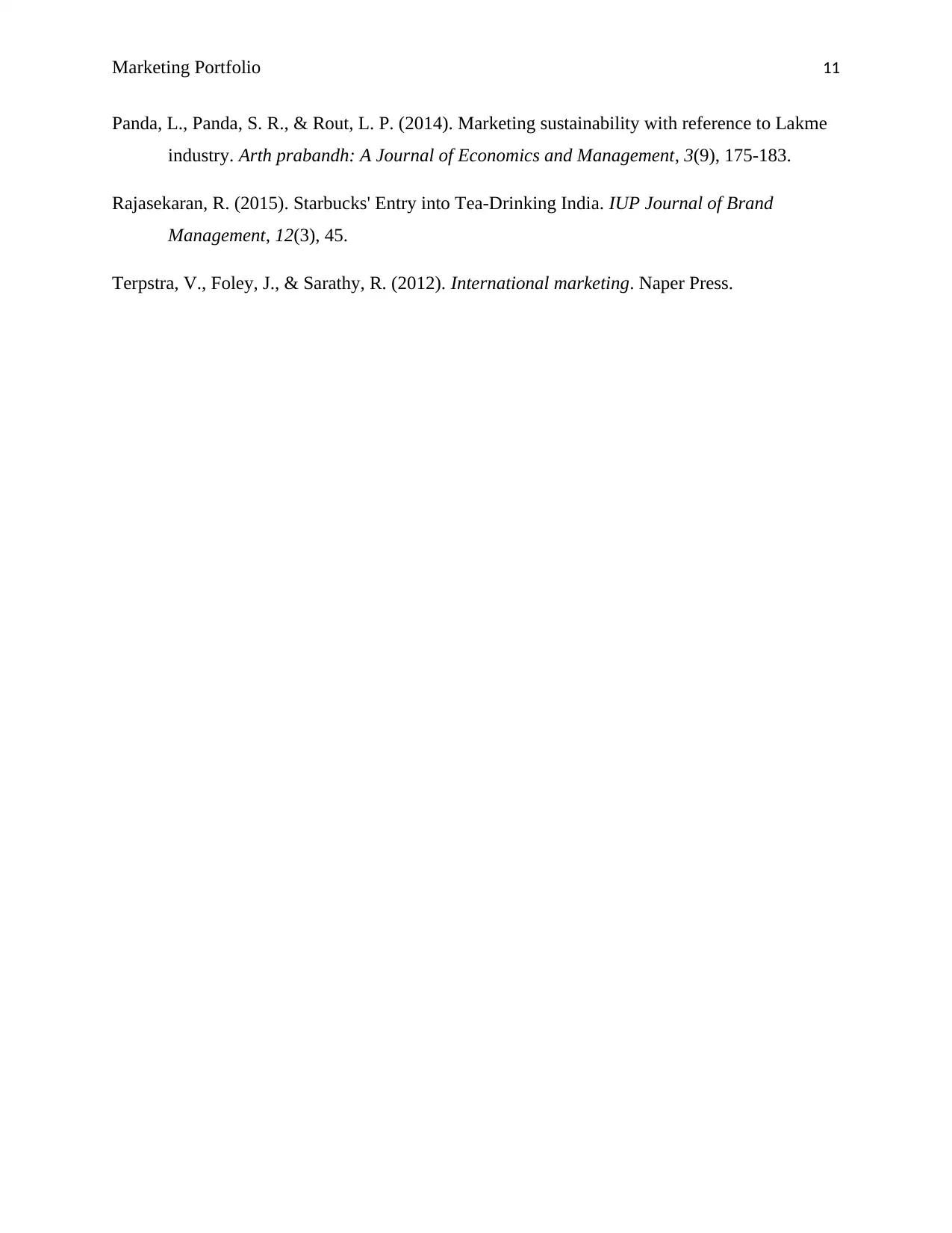
Marketing Portfolio 11
Panda, L., Panda, S. R., & Rout, L. P. (2014). Marketing sustainability with reference to Lakme
industry. Arth prabandh: A Journal of Economics and Management, 3(9), 175-183.
Rajasekaran, R. (2015). Starbucks' Entry into Tea-Drinking India. IUP Journal of Brand
Management, 12(3), 45.
Terpstra, V., Foley, J., & Sarathy, R. (2012). International marketing. Naper Press.
Panda, L., Panda, S. R., & Rout, L. P. (2014). Marketing sustainability with reference to Lakme
industry. Arth prabandh: A Journal of Economics and Management, 3(9), 175-183.
Rajasekaran, R. (2015). Starbucks' Entry into Tea-Drinking India. IUP Journal of Brand
Management, 12(3), 45.
Terpstra, V., Foley, J., & Sarathy, R. (2012). International marketing. Naper Press.
1 out of 11
Related Documents
Your All-in-One AI-Powered Toolkit for Academic Success.
+13062052269
info@desklib.com
Available 24*7 on WhatsApp / Email
![[object Object]](/_next/static/media/star-bottom.7253800d.svg)
Unlock your academic potential
© 2024 | Zucol Services PVT LTD | All rights reserved.





